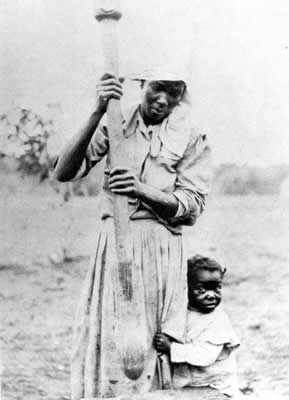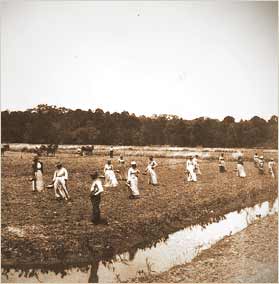
The black swamp, lily pads and cypress trees on a one time rice plantation.
A Feat as Great as Building the Pyramids
Rice cultivation is dirty, hard, dangerous work. Contemporaries compared the work of converting 150,000 acres of virgin land into tidal plantations as an undertaking comparable to building the Pyramids or re-channeling the Euphrates River.
An acre of mud flats would be measured into a rectangular field. Slaves would clear the land, chopping down and burning or removing any trees. Oxen were the only draft animals that might be used to assist, but they had to wear a special boot or else they would sink in the muck. Using only picks and shovels, slaves excavated a five-by-five foot ditch through the clearing that would serve both as the canal that brought tidal waters to the field and its main drain. The slaves used the muddy soil they had excavated to form a levee as high as six feet tall around the field. Slaves constructed sluice gates (first of cypress plug trunks and later hanging floodgates) to drain the water from the field for sowing and flood it for cultivation. Typically the following season, the field would be divided into four ¼-acre sections. Slaves added quarter drains (secondary canals) and cleared stumps. With the extra weight of water-laden soil, the danger of snakes and alligators that had been stranded behind the levee, mosquitoes and hot summer temperatures, the slave's work was dangerous and exhausting.

The cultivation of the rice began in late spring, around April, with the seed being sown. Ploughs were dragged through the wet soil to create furrows about three inches deep spaced 18 inches apart. Then, the slaves planted the rice in rows called drills. Slaves' daily work included operating the sluice gates with the tides. They flooded the fields following their planting of the seeds to the time of sprouting. After three weeks, they weeded and flooded the plants to cover the top of the young plant, gradually draining it halfway down the stem after a few days. The fields were drained and weeded, and the ground around the plants "hilled up" (hoed). Around mid-June or early July, the plants were gradually flooded and remained underwater for two months. Slaves freshened the water in the fields to keep it from stagnating. Tidal water is where fresh, inland water meets the salt water of the ocean. Fresh water rises on top of salt water, so the rice fields would be sown below the level of the high tide. A slave would open a sluice gate to skim off the fresh water floating on the top of the tidal waters to irrigate the crop, shutting it off before the salt water could intrude and kill the plants. At low tide, the gates were reopened to drain the fresh water out. A slave would be expected to weed a 105 foot square plot (¼-acre) in one day. Charles Ball, a runaway slave reported:

Rice must be processed to be the familiar white grain we see at the grocery store. The seed shell has to be removed, and then the brown coat of bran polished off the grain. Slaves used wooden mortars and pestles to mill the rice, separating the hulls from the grain with hand-sewn black rush winnowing baskets. An account from 1775 reported, "When winnowed it is ground, to free the rice from the husk; this is winnowed again, and put into a mortar large enough to hold half a bushel, in which it is beat with a pestle by negroes to free it from its thick skin; this is very laborious work." Following the pounding, the grain was sifted to remove the flour and dust produced in the process, and finally the rice was run through a market sieve, which separated the whole grains from the broken grains. Grains that were damaged in the process were called "little rice" and brought a lower price than whole grains. When the rice was clean, it would be placed in barrels that held roughly 600 pounds each. Rice mills appeared in the late 19th century, first operated by oxen, then by water (Jonathan Lucas, 1787), and finally tide-operated (1792). Although much of the work was back-breaking, unskilled labor, skilled slave artisans, such as carpenters, coopers, millwrights, and surveyors, contributed a great deal to the engineering, construction, and maintenance of the rice plantations.

Rather than the "gang system," where overseers or drivers directly supervised a group of workers, most rice plantations used the "task system," a specific amount of work that an average hard-working slave could complete in ten hours. When the slave completed the work to the driver's satisfaction, he or she could use the remaining hours of the day for their own purposes. Typically work began at dawn to avoid the worst heat of the day.
On rice plantations, a daily task might be the excavation of 24 linear feet of main drain excavation (the ditch dug five-by-five feet for each linear foot) or 133 feet of quarter-drain excavation (three feet by 18 inches). Sam Polite, a freedman, explained:

Every slave have task to do, sometime one task, sometime two, and sometime three. You have for work till task through. Have to cut cord of marsh grass maybe. Task of marsh been eight feet long and four feet high...If slave don't do task, they get licking with lash on naked back.
Fugitive slave Charles Ball reported one overseer's method of controlling slaves:
I gave them a hundred lashes more than a dozen times; but they never quit running away, till I chained them together, with iron collars round their necks, and chained them to spades, and made them do nothing but dig ditches to drain the rice swamps. They could not run away then, unless they went together, and carried their chains and spades with them. I kept them in this way two years....

Deadly Work
If a work could be imagined peculiarly unwholesome and even fatal to health, it must be that of standing like the negroes, ankle and mid-leg deep in water which floats an ouzy mud, and exposed all the while to a burning sun which makes the air they breathe hotter than the human blood; these poor wretches are then in a furness of stinking putrid effluvia.

Up to a third of Low Country slaves died within a year of their arrival. Records from Somerset Place Plantation in North Carolina indicate that 80 Africans were brought to the site in June 1786 to transform the land into a rice plantation. By 1803, only 15 of the original 80 slaves were still alive. At Gowrie Plantation in South Carolina during an eight-year period between 1846 and 1854, 92 more slaves died than were born; 90 percent of the infants who survived birth died before they were 16 years old.

Part of the problem was poor health. The environment in which rice is cultivated is the perfect breeding ground for mosquitoes. Both malaria and yellow fever may have been introduced from Africa to the rice cultivation regions by the slave trade. Slaves suffering from malaria may have brought the disease to the New World, where it infected Anopheles mosquitoes. Yellow fever victims would not have survived the Middle Passage, but Aedes (Stegiomyia) aegypti mosquitoes could have bred in the slave ships' open-water barrels. A sickle cell genetic defect provided protection from malaria to some slaves, while yellow fever survivors had a lifelong immunity to the disease. Nonetheless, malaria and yellow fever claimed the lives of many slaves working the rice plantations. Zamba, an African king brought as a slave to South Carolina, reported, "Under the influence of a powerful sun, this practice naturally produces what is called marsh miasma, which engenders fevers of a dangerous nature: fatal, indeed to white men in most cases; and even negroes, in some seasons, suffer greatly from it."

Slaves' nutrition, clothing, and shelter typically were poor. A pint of boiled rice, a pint of cornmeal, and either a couple of pounds of butter or fat rendered from bacon were a slave's typical daily ration, supplemented by salt and molasses. Those slaves who completed task work might grow vegetable gardens with beans or yams or fish, if near the water, to improve their diet. Although high in carbohydrates, it was a low-protein, low-calorie diet for persons involved in heavy physical labor, and the resulting malnutrition contributed to slaves' early deaths. Slave quarters consisted of wooden frame buildings in which a family or a group of individuals lived. They were inexpensive to build, Johann Bolzius explained, because "One buys only a few nails for them." They were also flimsy and prone to fire. Most plantation owners provided their slaves with five yards of heavy, coarse cloth from which to make winter clothing each year and a pair of shoes. Slaves might spin their own summer clothing, although some provided linen pants or skirts, and a cap or kerchief for head cover. Some plantations had sick rooms or slave hospitals, but since doctors didn't know the cause of fevers and resorted to blood-letting and purging medicines, slaves may have fared as well (or as poorly) remaining in the slave quarters and taking home remedies.

Working in the kitchen at the old rice plantation
As rice plantations expanded, the demand on slaves and their labor increased. Modern economists have noted that, unlike virtually every other slave-produced commodity, the output per slave in the rice industry grew from 2,250 pounds around 1750 to over 3,000 pounds by 1800. In human terms, this represented an enormous amount of physical hardship and arduous labor.
Gold Mines of Grain
The cultivation of rice required not only a large initial investment of labor, but also required money. In the late 18th century, it cost £2,500 to establish a 200-acre rice plantation. Most of the money was required for the purchase of slaves (an estimated cost of £1,800). In 1710, Thomas Nairne estimated that it was necessary to have 30 slaves to start a rice plantation; contemporaries calculated that a field hand should produce a ton (2,000 pounds) of rice each year working on two to three acres of old rice fields or five acres of new rice fields.

Based on average prices for rice between 1768 and 1772, the average slave generated five-six barrels of rice worth £15 ($975). Between 1722 and 1770, slave prices averaged around $150; from 1780-1809 they were substantially higher, averaging $305 per slave. By 1850, prices averaged $480 per slave. In the 1760s and 1770s, prices for women slaves grew more quickly than for men and sometimes exceeded them. Since African women (rather than men) milled rice on a daily basis and broke less grain than inexperienced male slaves, this may have been a case of price responding to demand for an important skill. A contemporary remarked, "Rice is raised so as to buy more Negroes, and Negroes are bought so as to get more rice."
Consequently, rice plantations could produce profits of up to 26 percent, prompting one Savannah River planter to describe his rice fields as "gold mines." For example a Charles Manigault invested $49,500 in Gowrie Plantation in 1833, and, by 1861, the plantation was worth $266,000.



This website really has all of the information I needed concerning this subject and didn't
ReplyDeleteknow who too ask.
Review my weblog ... raw diet recipes pinterest